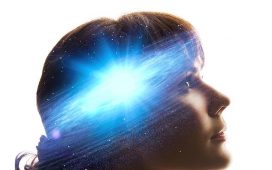
Thousands of people have watched the videos that the finalists and Popular Vote Regional Champions of Yuri Milner’s Breakthrough Junior Challenge have created. This is the 10th year that the contest has taken place, and the level of fun and creativity in the videos — available on Facebook and YouTube — is as high as ever.
The finalists are now waiting as the Selection Committee chooses the top five videos for final consideration alongside the Popular Vote winner. The overall champion will win three prizes. For themselves, a $250,000 college scholarship. For their school, a $150,000 science lab. And for a teacher who inspired them: $50,000.
Here are four of the finalists awaiting the winner announcement.
1. 16-Year-Old Grace Yihua Lee From the U.S.
Grace uses origami characters to bring Fermat’s principle of least time to life in her video. Her origami story explains how light particles bend between mediums to travel the quickest route. She also uses items like a pan of water and a wheel running over sticky tape to illustrate the science of refraction further.
2. 18-Year-Old Rephael Torrence S. Raagas From the Philippines
In his video, Rephael explains that capsaicin, found in chilli peppers, is the reason we feel hot when we eat spicy foods. He introduces the protein TRPV1, which senses heat when we eat these foods and is present in cells around the body.
Not only has this protein helped scientists understand why we get a burning sensation when we eat spicy foods, but it’s also led to improved research into pain relief patches, inflammation detectors, and cancer treatments.
Rephael garnered the most reactions to his video in Asia, making him the Regional Champion for this continent, as well as a finalist.
3. 15-Year-Old Joylin Song From the U.S.
In her video, Joylin explains why caffeine prevents us from feeling tired. She uses a race analogy, which she depicts in an animation. Adenosine (the chemical in our cells that makes us sleepy) runs through the human brain, trying to make it feel tired. But caffeine is competing in the race too — trying to stop adenosine from allowing the brain to become tired.
Joylin explains how different subtypes of adenosine receptors work. She also explains that the body produces more of these receptors to compete with caffeine when it blocks adenosine.
4. 18-Year-Old Conner Sisemore From the U.S.
In his video, Conner asks viewers to reflect on their younger years — a time that we likely felt moved at a slower pace. The older we get, the faster we feel time is moving. Conner explains that this is because, as children, our brains receive much higher volumes of new information.
He uses the example of a trip to the supermarket. During our first trips to a supermarket as a child, everything about this experience is new, and every second is packed with information. The older we get, the more we normalise the details of a supermarket.
Conner explains that the brain stores knowledge in the hippocampus and amygdala. As the hippocampus shrinks with age, our memory capacity lessens. Meanwhile, the neurons in the amygdala mature, which reduces our responses to emotional stimuli.
These are just 4 of the 16 finalists. View all the finalists’ videos here.
About Breakthrough Junior Challenge Co-Founder Yuri Milner
Since signing the Giving Pledge in 2012, philanthropist Yuri Milner has committed to giving much of his wealth to charity, including his competition the Breakthrough Junior Challenge.
Passionate about raising the profile of scientists, he created the Breakthrough Prize, which celebrates those paving the way for the future of physics, the life sciences, and maths with life-changing monetary prizes.
Aside from launching the world’s biggest science prize, Yuri Milner is also a co-founder of the Breakthrough Initiatives. These five science programmes plot searches beyond Earth for signs of extraterrestrial life.
On top of this, he supports displaced people through his non-profit Tech For Refugees. This organisation partners with some of the world’s biggest tech leaders to provide refugees with support ranging from accommodation to entertainment.
He is also the author of Eureka Manifesto: A Mission for Our Civilization, a fascinating read for anyone interested in humanity’s mission to explore and understand our Universe.












